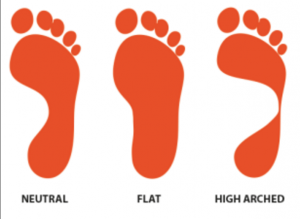Orthotics, also called orthoses, are devices that are worn in shoes to correct foot and ankle problems without surgery. Orthotics can be very helpful for a variety of foot ailments, including flat arches and foot and leg pain. They can also cushion your feet and provide comfort.
It is believed that only 10% of the population have what experts call “normal” or “neutral” feet. This means that 90% of the population could benefit in using orthotics. Orthotics help to maintain the foot’s shape as they support the body’s weight. This is accomplished by providing adequate foot arch support and balancing the imperfections in the patient’s legs.
Feet support the entire skeleton, so if they are unbalanced, the entire body will be misaligned. Furthermore, when these imperfections are not corrected, they can lead to abnormalities in the lower limbs, pelvic and lower back, especially if the patient makes repetitive strains or overuses these zones (like runners or athletes).
But, how do you know whether or not you really need to use orthotics? Try answering the following:
Analyze the Pattern of Wear on Your Shoes
The pattern in which your shoes wear out can offer clues about your stride. If one side shows more wear than the other, you are exerting more pressure on this side of the foot. You are either pronating (rolling the foot inward) or supinating (rolling the foot outward, so the ankles turn out) your feet. If one shoe wears out quicker than the other you may have a leg longer than the other.
Test Your Arches
Try this simple test to determine what kind of arches you have. Stand up in bare feet and then transfer your weight all to one leg. If that foot maintains the arch you do not have any structure problems of pronation or supination. If you have no arch and the foot is flat, you have pronation on that foot. Alternatively, if the arch becomes bigger or more prominent, you have supination on that foot. Supinators and pronators can both benefit from orthotics.
Another test you can do is called the Wet Test. Simply step onto a piece of paper with a wet foot and then view the silhouette of your foot. If you do not have a C curve this could mean you pronate and if your C curve is pronounced you could supinate.
Sore Feet and Heel Pain
This one may seem obvious, but so many people suffer from sore feet but yet don’t do anything to remedy it. In most cases, sore feet are caused by uncomfortable shoes that do not fit the foot properly. High heels and pointed toes shoes are especially bad. Repeated exposure can lead to permanent damage to the feet structures. Heel pain is not normal and can be signs of a foot condition such as Plantar fasciitis that should be medically treated.
Prior Injuries in Lower Limbs
If you have experienced a lower limb injury it is important you align your gait or otherwise you may have issues aligning the rest of your joints.
If you are presenting any of these signs we recommend visiting us for an evaluation of how we can best treat your situation.


